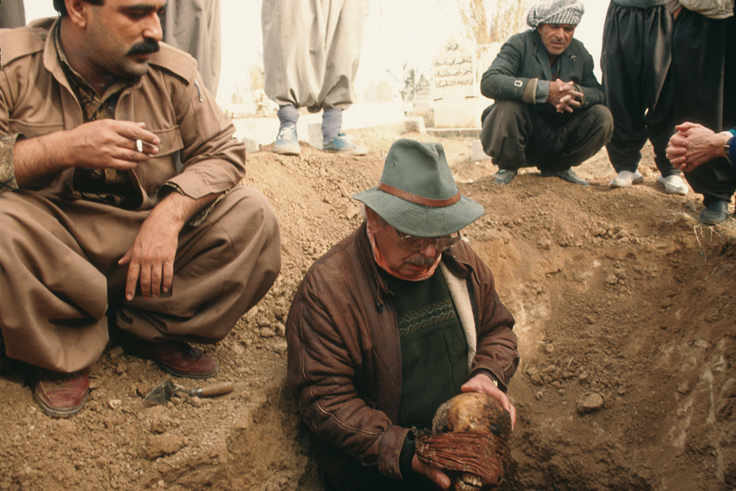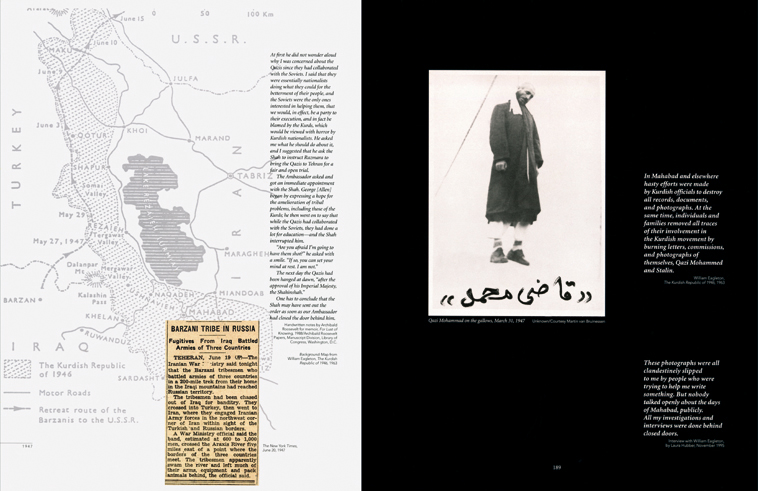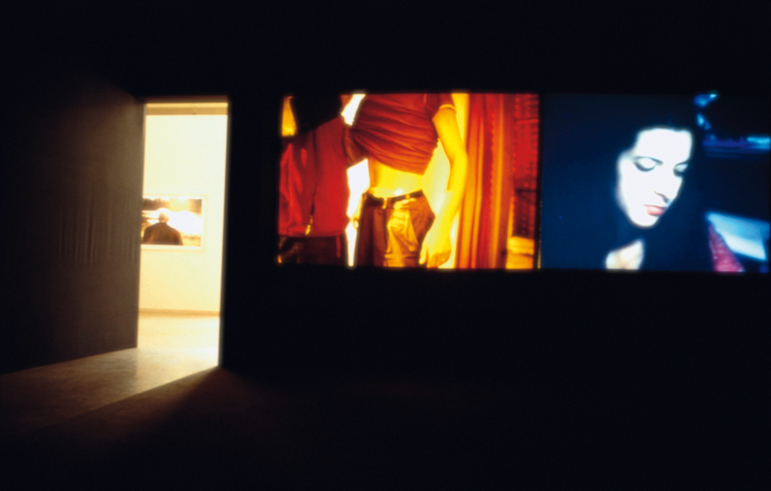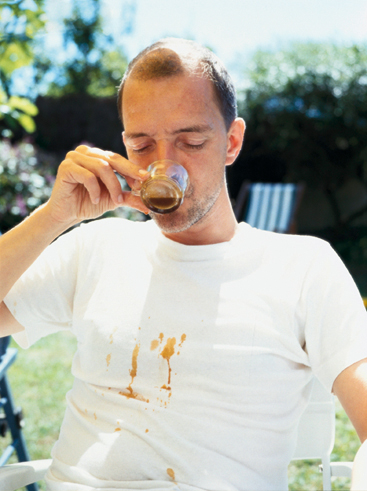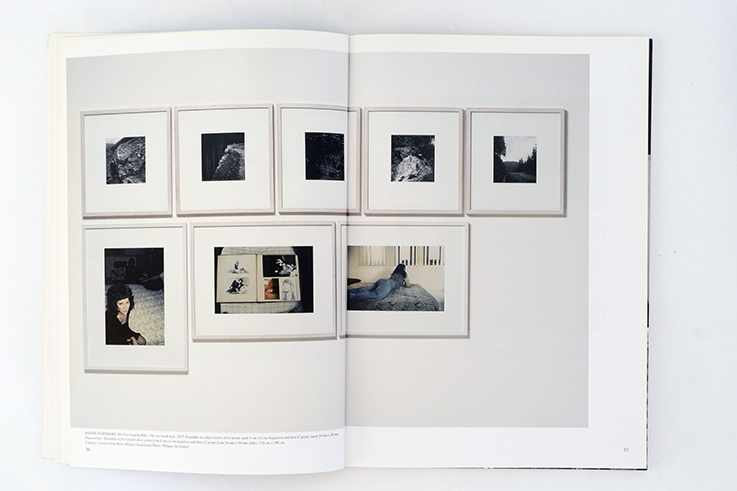Camera Austria International
95 | 2006
- ALLAN SEKULA
A Portable National Archive for a Stateless People: Susan Meiselas and the Kurds - SUSAN MEISELAS
Kurdistan. In the Shadow of History - SUSAN MEISELAS
- ROBERT OLSON
The Kurds: Are the Angels smiling? - NURIA ENGUITA MAYO
Rainer Oldendorf: Images in Absentia - RAINER OLDENDORF
- MIHNEA MIRCAN
A conversation with Santiago Sierra - SANTIAGO SIERRA
- RUTH SONDEREGGER
Critical Theory of Social Pictures III
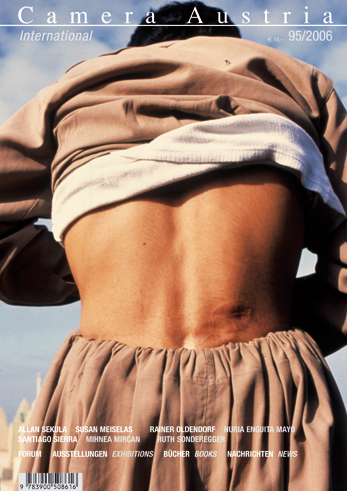
Preface
At various places in this issue of Camera Austria No. 95 we look into the question as to “how society and politics enter the picture”: Ruth Sonderegger examines this topic among other things by taking a look at artistic positions that worked not on but rather with the social role of images in recent years, and it just so happens that we will be continuing our contributions to the documenta 12 magazines project, that we kicked off in Camera Austria94 with Jo Spence’s essay “Questioning documentary practice?”, by continuing to focus on the “social use of images”.
Read more →Camera Austria International 95 | 2006
Preface
At various places in this issue of Camera Austria No. 95 we look into the question as to “how society and politics enter the picture”: Ruth Sonderegger examines this topic among other things by taking a look at artistic positions that worked not on but rather with the social role of images in recent years, and it just so happens that we will be continuing our contributions to the documenta 12 magazines project, that we kicked off in Camera Austria94 with Jo Spence’s essay “Questioning documentary practice?”, by continuing to focus on the “social use of images”.
In his essay “Photography and the borders of national identity”, Allan Sekula introduces an extraordinary project by the American photographer Susan Meiselas: “Kurdistan. In the Shadow of History”, that we will be proposing as another contribution to documenta 12 magazines. Meiselas first visited Kurdistan in 1991 with the aim of creating a photo documentation of the identification of the victims of Iraqi offensives in 1988. The result after more than six years of research was an archive on Kurdistan, that has grown as an exhibition, website and book into a “portable national archive” (Allan Sekula) of the Kurds (a people without a state). We have been following the progress of this project since Susan Meiselas commented on this incipient work at our photography symposium on the subject of WAR in autumn 1993 (cf. Camera Austria No. 47/48, 1994). Here, Meiselas talks about the problem of “how to engage and how to implicate. I work within the media and outside it. For we do not only make these images but somehow have to create the space for them to live”, and it is therefore important to us to provide space for a project that so profoundly challenges the (often rashly drawn) borders of photographic documentation.
In a site-specific work at Bucharest’s National Museum of Contemporary Art, that opened in a wing of the parliamentary palace in 2004, Spanish artist Santiago Sierra focuses on the political significance and symbolism of this building. Erected as the “Palace of the People”, it is the second-largest building in the world, a megalomaniac expression of political power and despotism, isolated and cut off by its vast mass from life in the city that had to yield one third of its size for construction of this complex: “a totem of evil, of the terror in the city”, as Sierra characterises the building. In an interview with Mihnea Mircan, curator of the “Under Destruction” project series as part of which Santiago Sierra created his “Corridor in the House of the People”, the artist talks about his work, in which he has dealt with the national self-image of Romania and the allocations of national stereotypes to Romania at the time of its imminent integration into the European Union and the concomitant expectations and doubts.
Unlike Santiago Sierra, who always provides an oppressive political commentary on the history and present situation of the locations of his actions, Rainer Oldendorf examines forms of political activism in a very different, subtle ways. In his photographs and films and in his exhibition settings, he translates fragments of his own biography and political socialisation in the form of snapshots in a constant, meaning-evoking game into the present, again and again, further and further, weaving them together in new, different ways to create a tight mesh of social relationships and interactions. In this process, his work, about which Nuria Enguita Mayo has composed an introductory essay, acts not only as a kind of constant memory work, but also as visualisation of social and political relationships in which he finds himself and on the basis of which he creates his pictures and film works. In allusion to a supposedly collective “knowledge” he succeeds for instance in the “Marco” film project with its variously open narration on armed resistance since the 1970s – in involving the viewer in his work as a kind of accomplice a topic on which we will also be focusing in an exhibition at this year’s steirischer herbst festival.
Christine Frisinghelli
Entries
Forum
MARKUS DORFMÜLLER
SPENCER MURPHY
SURENDRA LAWOTI
STEFANO GRAZIANI
LILI ALMOG
NICOLAI HOWALT
TRINE SONDERGAARD
MICHAEL STRASSER
MORTEN NILSSON
Exhibitions
Yael Bartana: Videoarbeiten.
Kunstverein in Hamburg
JENS ASTHOFF
Nothing But Pleasure.
BAWAG Foundation, Wien
MANISHA JOTHADY
Tacita Dean: Analogue. Films, Photographs, Drawings 1991 – 2006.
Francis Alys: The sign painting project (1993 – 1997). A Revision.
Schaulager Basel
RAINER BELLENBAUM
Mensch! Photographien aus Dresdner Sammlungen.
Kupferstich-Kabinett Dresden.
Nachbilder. Photographie in der DDR.
Tagung in Dresden.
MARGARETHE SZELESS
Kurt Kren:Das Unbehagen am Film.
Atelier Augarten, Wien.
DREHLI ROBNIK
Horàkovà+Maurer: Arbeiten 1996 – 2006.
Fotogalerie Wien in der Akademie der bildenden Künste, Wien
WERNER FENZ
Why Pictures Now. Fotografie, Film, Video Heute.
Museum Moderner Kunst Stiftung Ludwig Wien
ROLF SACHSSE
Erika Sulzer-Kleinemeier: Fotografie.
Ursula Blickle Stiftung, Kraichtal
DORIS BERGER
Paris: Museumsneugründung und -Eröffnung.
Musée du quai Branly, Paris
HERWIG HÖLLER
PHotoEspaña 2006: Naturaleza. International Festival of Photography and Visual arts.
Madrid
ALBERTO MARTÍN
Snap Judgments. New Positions in Contemporary African Photography.
International Center of Photography, New York; Miami Art Central
RACHEL BAUM
Out of Beirut.
Modern Art Oxford
NIELS HENRIKSEN
Dietmar Busse: New Photographs.
Sara Tecchia Roma New York
CARLO MCCORMICK
Raconte-Moi / Tell Me. Film and Narration in Migration.
Musée National des beaux-Arts, Québec; Casino Luxembourg – Forum d’art contemporain, Luxembourg
YOANN VAN PARYS
Click DoubleClick. The Documentary Factor.
Haus der Kunst, Munich; Centre for Fine Arts, Brussels
STEVEN HUMBLET
William Wegman: Funney / Strange.
JO LONGHURST
Whitney Biennial 2006: Day for Night.
Whitney Museum of American Art, New York
RACHEL BAUM
Books
Rob Hornstra: Roots of the Rúntur.
National Museum Iceland, Reykjavik, 2006
ÆSA SIGURJONSDOTTIR
Nikolaus Walter: Fotografien 1967 – 2004.
Hatje Cantz, Ostfildern-Ruit 2006
JASMIN HASELSTEINER-SCHARNER
Frieda Grafe: Schriften.
ANNETT BUSCH
ARNO SCHMIDT? – Allerdings!
Deutsche Schillergesellschaft, Marbach 2006
KRYSTIAN WOZNICKI
Imprint
Publisher: Manfred Willmann. Owner: Verein CAMERA AUSTRIA, Labor für Fotografie und Theorie
All: Lendkai 1, A-8020 Graz
Editors Graz: Reinhard Braun, Christine Frisinghelli, Tanja Gassler
Editor Berlin: Maren Lübbke-Tidow
Copy editing: Marie Röbl
Translations: Wilfried Prantner, Richard Watts, Josephine Watson, Aileen Derieg, Don Mader, Bernard Reeves

